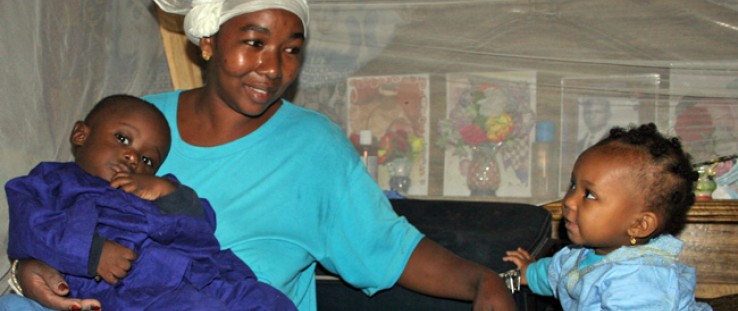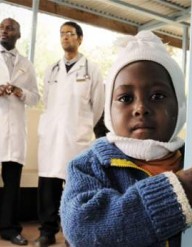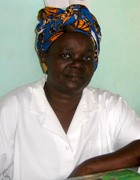 In 2009, at least 82 percent of households in Senegal had at least one bednet compared with 36 percent in 2006. Here, Rougiatou Diallo settles down for a nap with her two children, Serigne Fallou, 3, and Mame Cor, 1.
Richard Nyberg, USAID
In 2009, at least 82 percent of households in Senegal had at least one bednet compared with 36 percent in 2006. Here, Rougiatou Diallo settles down for a nap with her two children, Serigne Fallou, 3, and Mame Cor, 1.
Richard Nyberg, USAID
 In 2009, at least 82 percent of households in Senegal had at least one bednet compared with 36 percent in 2006. Here, Rougiatou Diallo settles down for a nap with her two children, Serigne Fallou, 3, and Mame Cor, 1.
Richard Nyberg, USAID
In 2009, at least 82 percent of households in Senegal had at least one bednet compared with 36 percent in 2006. Here, Rougiatou Diallo settles down for a nap with her two children, Serigne Fallou, 3, and Mame Cor, 1.
Richard Nyberg, USAID
Long before the United States launched the President’s Malaria Initiative (PMI), Fatou Diouf was going house to house in her village of Kignabour in Senegal to keep malaria and other illnesses from sickening her neighbors.
Twenty-eight years later, and with a fresh injection of U.S. support, she is proud of the impact her work continues to have on her community.
“This year, for example,” she said, “we had in all of the village only one case of malaria—from a population that totals 1,553 inhabitants.”
In the five years since it was launched, the PMI, which is led by USAID and implemented together with the Centers for Disease Control and Prevention, has moved closer to its goal of cutting malaria-related deaths in half.
The U.S. Government has allotted $1.2 billion in 15 African countries on malaria prevention and treatment. The program puts a special focus on pregnant women and children under age 5—the groups at greatest risk of dying from the disease.
Officials say that global malaria control efforts, including the PMI, have helped cut malaria cases in half in more than 40 countries.
“Today we help save nearly 150,000 lives every year,” USAID Administrator Rajiv Shah said on World Malaria Day 2011, April 25. “In seven of the original 15 Presidential Malaria Initiative countries, we’ve seen reductions in all-cause child mortality by 23 to 36 percent. Once more data becomes available, we expect to see similar results in the remaining initiative countries.”
Malaria is entirely preventable and curable, which makes it a prime target for the global health community. But as backers of the PMI and other efforts know, those efforts are not easy or inexpensive.
A Challenging Disease
Malaria has been around for centuries and is spread by the bite of the female Anopheles mosquito. Once endemic, malaria has been eliminated from most developed nations for many years. It is the poorest nations and those in tropical climates—prime real estate and reproductive territory for mosquitoes—where malaria is stubbornly staying put.
About 1 million people die of malaria annually. Between 300 million and 500 million people will get the disease each year, and most live in sub-Saharan Africa. Uncomplicated malaria causes flu-like systems, such as fever, headache, and vomiting. If left untreated, the disease quickly can lead to death. Even if a child survives severe malaria, he or she is often left with chronic disabilities—hearing loss, paralysis, and learning disabilities.
An estimated 30 percent of all outpatient visits and inpatient admissions among children under 5 in Africa are due to malaria. And in the economic realm, the disease results in $12 billion in lost productivity every year on the continent.
Muscular U.S. Response
Working with other U.S. Government and international partners, the PMI uses a mix of tools: long-lasting insecticide-treated bednets, indoor insecticide spraying campaigns, artemisinin-based combination therapies, prevention of malaria in pregnancy, and community education campaigns. The PMI is also helping train lay and professional medical personnel to care for people with malaria, and is helping governments take charge of malaria campaigns in their own countries.
“The United States is focusing on building capacity within host countries by training people to manage, deliver, and support the delivery of health services, which will be critical for sustained successes against infectious diseases” like malaria, said U.S. Global Malaria Coordinator Timothy Ziemer.
And, while a malaria vaccine is not on the immediate horizon, USAID is backing researchers and pharmaceutical companies in the effort.
Knocking on Doors, Saving Lives
For now what is happening on the ground in malaria-affected communities is vital. And community health workers like Fatou Diouf are key to the activities.
Diouf is part of USAID/Senegal’s integrated community case management program, which is supported by the PMI and uses trained community workers to provide basic health services. One of the greatest barriers to rapid and effective treatment of malaria in Africa is lack of access to health facilities for people living in rural areas. Many countries deploy community health workers to compensate for the limitations of their formal health-care systems.
Diouf, who was selected by her community to train as a health worker in part because of the long distance to health facilities, says the people she serves today know more about malaria than when she started two decades ago.
In the beginning, some people declined to use bednets or used them improperly, she said. Some even told Diouf they did not need to use bednets because they saw no mosquitoes in their rooms. Today, Diouf, 53, goes door to door to educate families about malaria and the proper use of bednets. As a member of the community, she easily won their trust.
Senegal and Malaria Eradication
“Senegal’s northern areas could be malaria-free in the next few years. Indeed, some districts have already achieved this impressive goal,” the country’s health minister, Modou Diagne Fada, said late in 2010. “This is the first time that our country has achieved a level of malaria control that could put malaria elimination within reach.”
In-country malaria-control experts say funding from the PMI and other sources was key to vastly increasing bednet distribution—in late 2009, at least 82 percent of households had at least one bednet compared with 36 percent back in 2006—and to providing other malaria-related services to as many people in the country as possible. The country recruited celebrities, well-known athletes, and religious leaders to support its efforts.
The PMI also tracks closely to the newer Obama administration push, the Global Health Initiative (GHI), which began last year. The GHI, like the PMI, looks to reduce disease and promote healthy communities with a particular emphasis on women, babies, and young children.
The PMI, which was reauthorized for another five years in 2009, will run through fiscal year 2013. With its renewed funding, the PMI is a key component of the comprehensive GHI. In Senegal, PMI represented over 40 percent of donor support for malaria control in 2009.
GHI-PMI Double Punch
“I believe we can save an additional 500,000 more lives a year, most of them young children,” Shah said. “To do this, we need to scale up the distribution of insecticide-treated bednets, boost indoor residual spraying, use more effective antimalarial drug therapies, and target vulnerable populations for treatment.”
That will take additional funding in a time when national and global budgets are tight. Or, as Ziemer put it at a malaria conference in Oslo earlier this year, “we have to go forward with a heavy dose of reality because there will be less money.”
Forming partnerships, including with the private sector, will be key to stretching scarce government resources, he said. The PMI announced recently that it is collaborating with the U.S. Peace Corps in 14 African countries where the two efforts overlap to expand malaria control and prevention.
Ultimately, health advocates say a vaccine against malaria is needed to eradicate the disease, much like what occurred with small pox and polio decades ago. USAID was critical to both efforts. Researchers believe that an effective vaccine could take another 10 to 15 years.










Comment
Make a general inquiry or suggest an improvement.